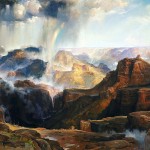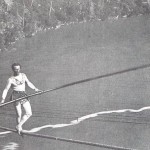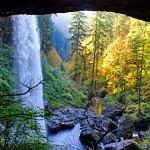by Helen King
I’m currently visiting Oregon, and my host took me to see the huge waterfalls at Silver Falls State Park. I’ve seen Niagara Falls, and while the Oregon ones are clearly not in that league, they are very beautiful, not least because of their temperate rainforest setting.
But why do I find them ‘beautiful’? As I bent down to pass under the overhanging rock – lava, from the volcanic past of this region – I was also aware of the risk of rock falls, of slipping and falling into the cold water underneath tons of water gushing down with enormous force. When does something in wild nature become attractive rather than terrifying?
This is a historical question. Wild nature has not always been beautiful. It has been argued that the ancient Roman interest in killing wild animals in the arena was all about showing their control over nature. Nature was there to be defeated, or to be managed, but not to be enjoyed. The controlled wilderness of the eighteenth-century park shows further how the environment can be tamed, domesticated. It was the Romantic movement, strongest in the first half of the nineteenth century, which led us to see nature in a different way. The range of emotions conjured up by confronting nature – including fear and awe – were presented as an alternative to reason as a way of understanding the world. And just what counted as acceptable parts of nature also shifted.
The perfect example is the Grand Canyon. I’m lucky enough to have been there too, but it was not on my ‘bucket list’ at all – and it was so much more impressive than I could have expected, not least because of the weird sensation of one part of my mind saying ‘this is real, it’s 3D’ while another part was refusing to compute that, and kept making me see it as a painted 2D back-cloth.
But it was only in the late nineteenth century that the Canyon came to be seen as a ‘wonder’. Before that, it was a gap, rather than a view, a wound in the earth, an obstacle rather than a destination, a threat not an adventure. Due to going down rather than up, it was not even obvious to European explorers that there was anything there, until they were very close to it. In the mid-nineteenth century it was mapped by the government. When J.C. Ives explored it in 1857 he announced that it would remain an unvisited and ‘profitless locality’. It finally became a national monument only in 1908. Officially announcing it as such, President Roosevelt called it ‘this great wonder of nature’ and spoke of its ‘grandeur, sublimity and loveliness’.
The shift in perception of the Canyon was helped by art. The artist Thomas Moran and the photographer William Henry Jackson did much to bring the Canyon to people’s attention. Moran had already painted the Yellowstone Canyon, and in 1874 produced a companion piece, ‘The Chasm of the Colorado’. Like his Yellowstone painting, it was sold to Congress. The coming of the railway made the site more accessible, and other artists came to paint it. The director of the Santa Fe Railroad company gave them a free trip, in return for their paintings which were then reproduced on calendars so that the fame of the site spread. The canyon was attractive to artists partly because it represented such a challenge – was it even possible to capture it in a painting? It was attractive to business as a marketing opportunity.
Like his Yellowstone painting, it was sold to Congress. The coming of the railway made the site more accessible, and other artists came to paint it. The director of the Santa Fe Railroad company gave them a free trip, in return for their paintings which were then reproduced on calendars so that the fame of the site spread. The canyon was attractive to artists partly because it represented such a challenge – was it even possible to capture it in a painting? It was attractive to business as a marketing opportunity.
The challenge of these extreme sites has also led to a range of individual attempts to ‘conquer’ them. At Niagara Falls the performances of people such as Charles Blondin, in the second half of the nineteenth century, included a range of stunts while crossing it on a tightrope. A nd even the relatively ‘mild’ Silver Falls had their own performer, ‘Daredevil Al’ Faussett, who in 1928 went over one of the waterfalls in a canoe, with a cable rigged up to guide the canoe into the rather small area of water at the bottom of the falls. The cable malfunctioned but somehow Al survived. The exhibition at the Falls includes a film of him going over the edge, and ends with him sitting up in bed in the hospital, drinking a cup of tea and looking somewhat manic. Maybe nature is bad for one’s health!
nd even the relatively ‘mild’ Silver Falls had their own performer, ‘Daredevil Al’ Faussett, who in 1928 went over one of the waterfalls in a canoe, with a cable rigged up to guide the canoe into the rather small area of water at the bottom of the falls. The cable malfunctioned but somehow Al survived. The exhibition at the Falls includes a film of him going over the edge, and ends with him sitting up in bed in the hospital, drinking a cup of tea and looking somewhat manic. Maybe nature is bad for one’s health!
Do you feel the urge to conquer nature? Do you like to explore it, or stay away from it, and do you find it dangerous, or beautiful, or both?

